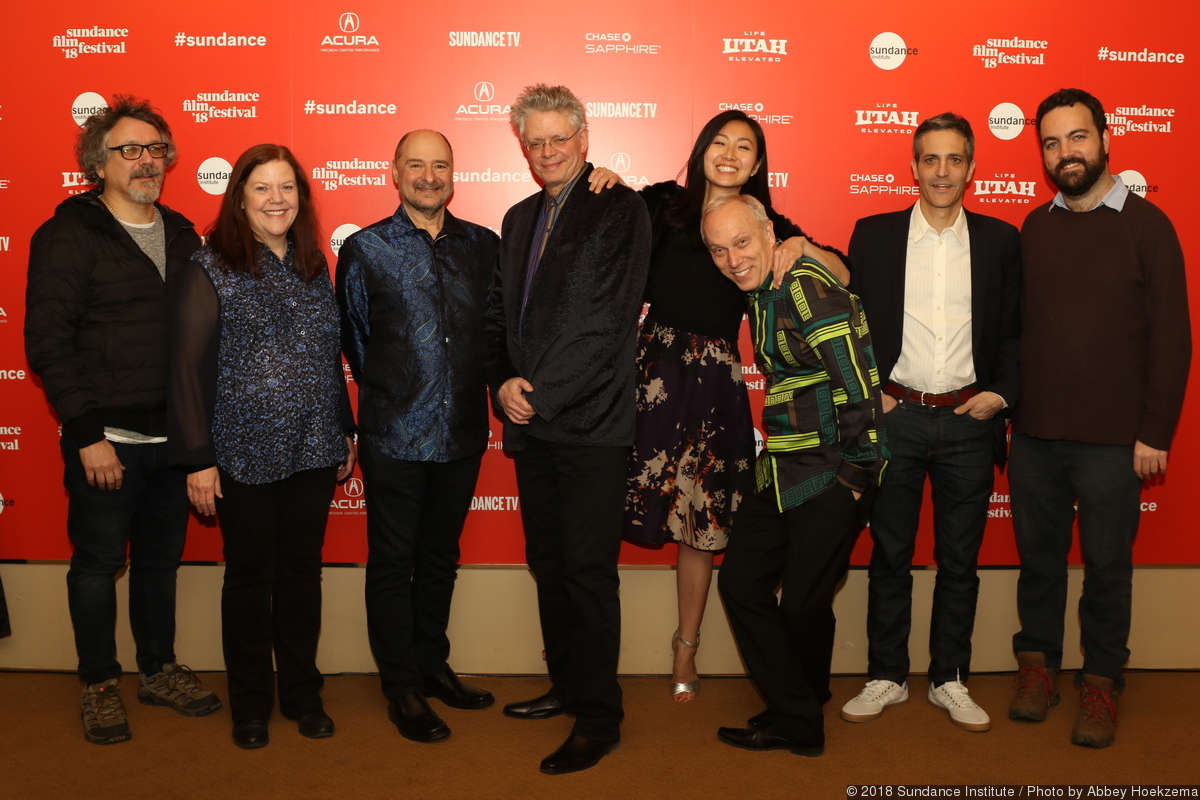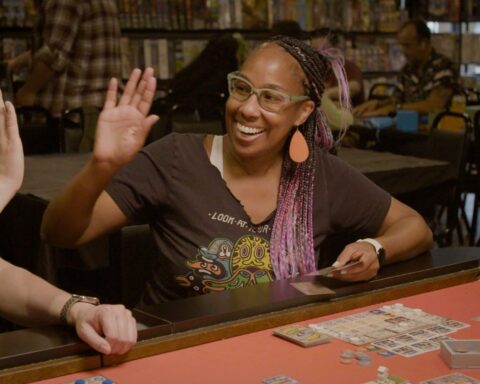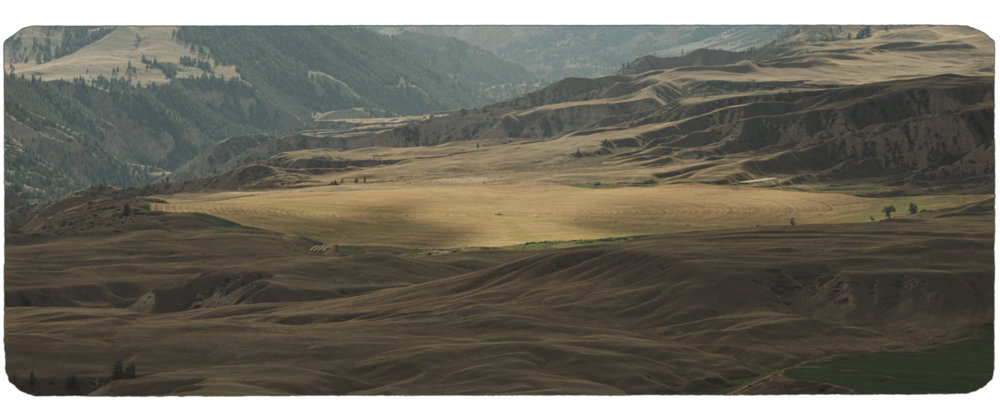A Thousand Thoughts is a “live documentary” about the avant-garde contemporary music ensemble the Kronos Quartet, which comprises an onstage musical performance by the group, narration by Green and carefully assembled footage projected on a screen behind the participants. These elements synergize to form a one-of-a-kind non-fiction presentation that twists documentary into new directions while requiring audiences to collectively experience an ephemeral, yet highly cinematic, work.
Green has been exploring this form since 2009, after an Oscar-nominated career in traditional documentary with films such as 2003’s The Weather Underground. For the Kronos project he formed a new collaboration with Joe Bini, former right-hand man to Werner Herzog. With celebrated cinematographer Kirsten Johnson shooting the footage that plays in concert to Kronos’ music and the onstage narration, there’s a veritable all-star team of non-fiction pros behind Green’s latest.
POV spoke with Bini and Green following the premiere of their project at the Sundance Film Festival in Park City, Utah.
POV: Jason Gorber
SG: Sam Green
JB: Joe Bini
POV: How did the notion of “live documentary” come to be?
SG: Eight years ago I was making an experimental documentary. It was four different stories about utopia woven together with no explanation. In my mind, it was this brilliant poem. Everybody said it made no sense whatsoever.
[Underground filmmaker] Craig Baldwin asked me to do a presentation about the project, to just show clips and talk. I said, well, that sounds kind of boring! I got my friend Dave Cerf to do to some live music and did this kind of fancy PowerPoint presentation which did everything I wanted the film to do. Utopia now made sense; people stuck around after and had this new kind of collective experience.
POV: You’re forcing people to see things differently. It’s an experience you can’t have at home.
SG: The idea of everybody watching Utopia at home on their laptop seemed really sad.
POV: When did you realize that you were working on a form that you would want to continue exploring?
SG: I loved going around with the movie and just got hooked on the form. In a way you’re using the tools of cinema at their fullest. Huge images and sound that washes over you—that’s the essence of the magic of cinema! A Thousand Thoughts definitely feels like the strongest of the ones I’ve done, because the form and the content are so aligned.
POV: How did the collaboration with Joe Bini come about?
SG: We met at the Sundance doc edit lab a few years ago when Joe gave a presentation about his work. I was totally smitten by it. Joe was sick of editing and I love collaborating with people. I edit and don’t need somebody to be an editor. But the great thing for me is working collaboratively with somebody.
JB: Sam gave a presentation where he talked about what he does. I was really taken by the idea that [what Sam is doing is not] necessarily a theatrical thing. I find more and more that you see very few documentaries that are theatrical—films that are any better on the big screen than they are on a tiny one. Most documentaries are not that; they just get stretched to be that.
POV: How do you differentiate between a cinematic documentary and a TV documentary?
JB: It could be because it has a strong enough story that I can recognize immediately it is a feature-length project, but it has to be subject to the same things that fiction’s subject to. Are the characters strong enough? Do the characters change? All of that—things you look for in a screenplay. The fucked up thing about documentaries is, as an editor, you can go three months just to get to a point where you realize that it’s not going to work.
POV: There was no issue of finding your space in this project?
JB: No. I love the fact that [Sam] can edit. I’ve been saying to filmmakers for years now—I don’t ever want to hear them tell me they can’t edit! It’s like a novelist saying they can’t type. It’s ridiculous.
POV: With Kronos you have an enormous archive with an amazing number of choices. They play lots of contemporary composers like Glass and Reich, but they also have worked with Bollywood singers and Tanya Tagaq. How did you choose what to show?
SG: You start off just by making scenes that you like, different things that strike you. I really liked showing their archive and talking about it. In particular, I enjoyed the Sesame Street clip. It’s funny and it also tells you a lot about [Kronos]. They’ve been around since the 70s and they’re still popular.
POV: Did you choose what Kronos played on stage?
SG: We picked all the music. When we first put it together with them, they had suggestions and some of them were great, like “Black Angels,” part of which they played on wine glasses. It was an intensely noisy section and they wanted to do it like that. I thought that was too abrupt, too abrasive for an audience, but there was a huge roar from the crowd. They liked it and Kronos was right. That was a good call.
JB: They pushed on doing some things like [Chinese composer and pipa player] Wu Man. That was theirs, [adding] some more diversity than what we had originally.
POV: Did you know what you didn’t want?
JB: We talked early on before shooting stuff about themes, because we knew we didn’t want to do a biopic. Honestly, it wasn’t even until we performed it [that] I finally realized that we actually pulled it off! You never know until it’s all there, since it’s such a whacked format.
POV: The filmed elements by Kirsten Johnson seem the most straightforward. How were those tweaked to better fit this project as a whole?
SG: When you do an interview, the chemistry is so important with the subject. [Kirsten] is such a magical presence that she really helped with everybody. An interview is a performance, and all of those performances are better because of her and her weirdo, lovely energy.
POV: How were these shot differently than regular talking-head elements?
SG: They’re shot really straight on so that in the theatre it’s big. I mean, ironically, the way we shoot would work for a really big theatre or an iPhone!
POV: On your computer there is a version of this which is a straight up doc, with temp score and narration…
JB: …Which has massive black holes in it.
SG: If I sent you a link of it, and you watched it as a traditional documentary, it wouldn’t work. There’d be long scenes where you’d be bored, like Tanya’s for example. On your computer, it would be way too long, but in real life it works.
POV: How did you shape the final cut?
JB: We did a week-long performance rehearsal. For me, that was mind-blowing because it was like, we don’t need this, we don’t need that. The coolest thing was we were re-cutting it while we were doing it.
POV: Kronos are not playing when their leader, David Harrington talks about a personal tragedy.
SG: It’s an unauthorized biography, and there’s stuff in there they’re not thrilled about. David’s son died tragically and he could not play the song over that [terribly sad story]. We went through different ways of trying to make it work. At first, we were just going to make them leave and come back. David didn’t want to do that. He wanted to stay on the stage, so what we came up with was just to bring the stage lights down.
POV: Even in the dark, you’re watching him on stage as on screen he tells this tragic tale.
JB: That is what’s intense about it. And then the lights come up. It was difficult for him to play after that.
POV: What drew you to documentary in the first place?
SG: I saw an obscure [1967] film called Holy Ghost People by a guy named Peter Adair. It was a black and white cinéma vérité movie about a snake handler congregation in Appalachia. It’s fucking magical and beautiful and I’d never seen anything like it.
JB: I had very little love for documentary. I’m more about form, so I got into them through Werner Herzog because he was making a weird form of documentary. I had a really stupid idea about what [documentary] was. I thought it was just factual stuff shot with people talking, blah blah. I realized through Werner that it can be all kinds of other things.
POV: How did Kronos respond to being part of a live documentary?
SG: Normally with musicians and filmmakers you send them a cut, they send you some files, [and then] you see them at the premiere. Because Kronos were there, they have to have more ownership. There was more back and forth. They would say, “it would be better if it was a little bit longer,” and you would recut it and then redo it, for a particular song or whatever. I feel the standing ovation at Sundance was for [Kronos], people appreciating the breadth and scope of what they’ve done.
POV: So you see no reticence in them continuing to be part of this project?
SG: Who wouldn’t want to be vigorously applauded?











